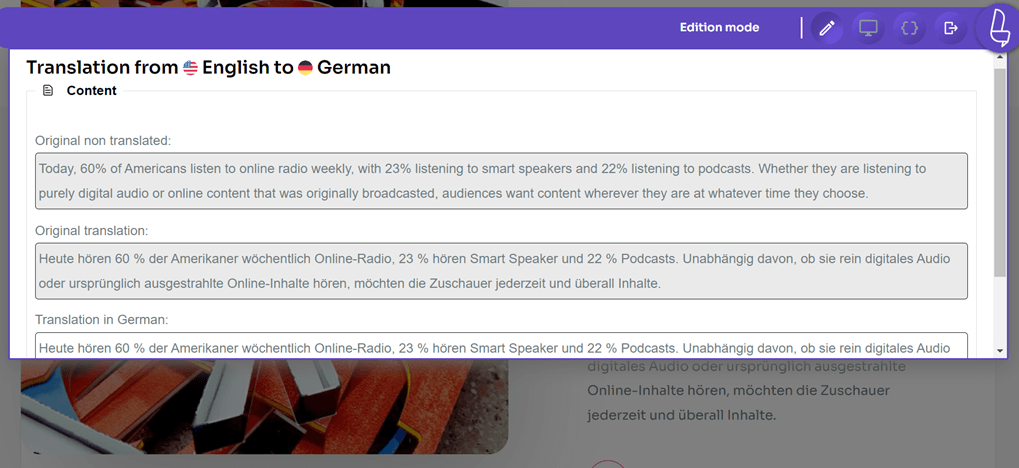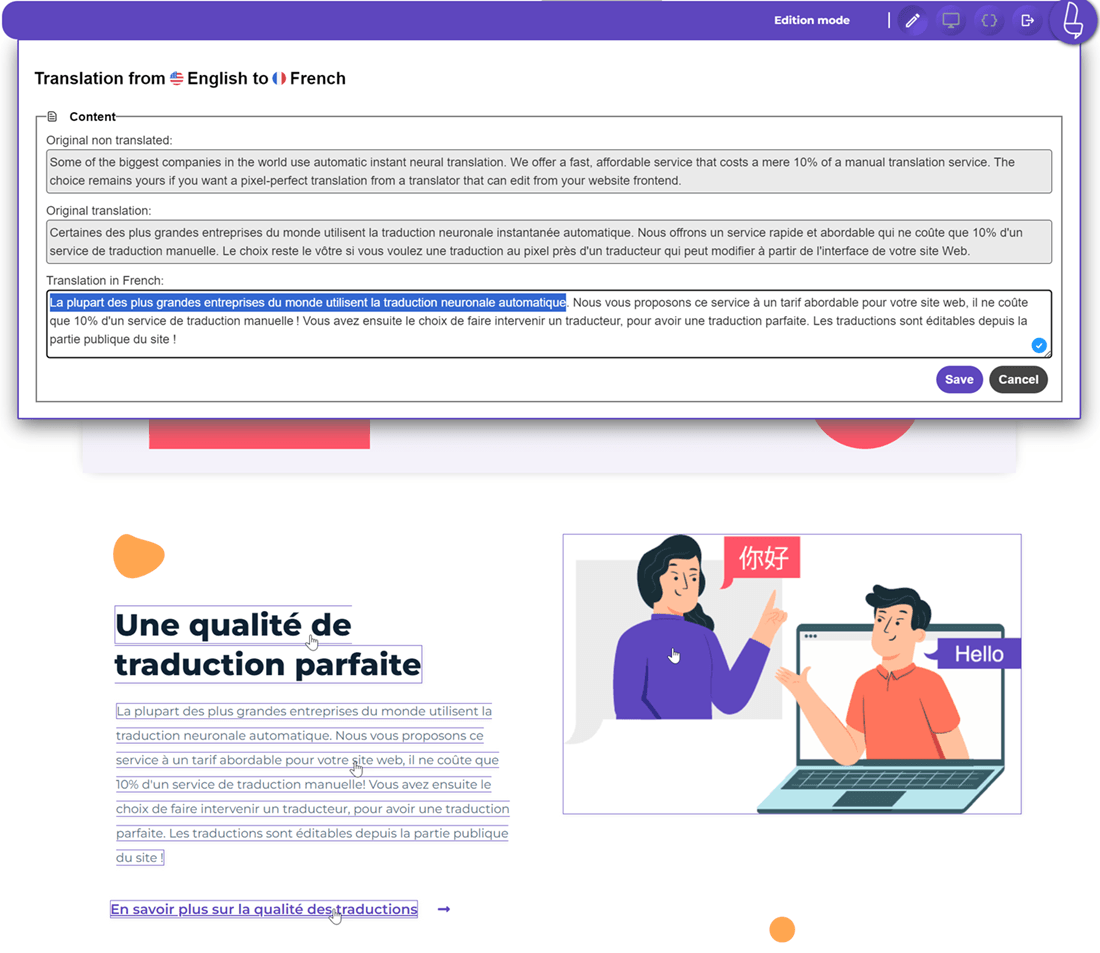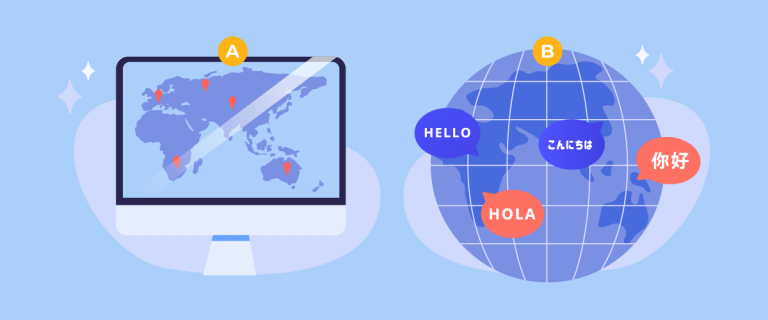Machine translation indeed provides quick results, although often, the translations are less accurate and may not suit the context well.
One of the main challenges in machine translation is the difficulty of deeply understanding the nuances and context of language. Machine translation tends to translate word by word or phrase by phrase literally, without considering the intended meaning in a specific context. As a result, the translations produced often sound stiff, unnatural, or even misinterpreted.
Therefore, to achieve perfect-quality translation, human intervention is required in the process of editing and improving machine translations. This is what is referred to as machine translation post-editing (MTPE). Learn more about what MTPE is in the following article!
What is machine translation post-editing (MTPE)?
Machine Translation Post-Editing (MTPE) is the process of combining the speed and efficiency of machine translation with human translation editors to produce high-quality translations after translating a website. Essentially, MTPE involves using machine translation software to translate the source text into the target language, which is then reviewed and edited by professional translators.
The MTPE process begins with machine translation, which translates the source text into the target language using algorithms and language models. Although machine translation can translate quickly and accurately, errors or lack of nuance and idiomatic expressions that can only be captured by humans still occur. Therefore, this is where the role of professional translators comes in.
They will review the machine translation output and make necessary edits to ensure accuracy, context suitability, and cultural appropriateness.
In this case, Linguise simplifies the post-editing of machine translations. The front-end live editor enables direct editing of translations in a live preview of your website. You can quickly check and make adjustments on your site. Alternatively, you can also edit through the admin dashboard.

Difference between MT and MTPE
Now that you know what post-editing machine translation is, then how is it different from machine translation? The following is a table that differentiates MT and MTPE from several aspects to make it easier for you to understand the differences.
Aspects | Machine Translation (MT) | Machine Translation Post-Editing (MTPE) |
Process | The translation is performed entirely by machine translation software/algorithms. | The initial translation is done by machine translation, then edited and corrected by professional human translators. |
Human involvement | There is no human involvement in the translation process. | Involves professional human translators to edit and improve the output of machine translation |
Translation quality | The quality of translation can vary and often still requires improvement. | Translation quality is higher and more accurate as human translators have edited it |
Time and costs | Faster and cheaper for large volumes of content. | Slower and more expensive compared to MT alone but faster and cheaper than complete human translation. |
Main use | Suitable for translating content that is not too long and complex. | Suitable for translating content that requires high accuracy levels and large volumes. |
Why not use human translation from the start?
Perhaps some of you may wonder why not use human translation from the start since it will eventually be reviewed by translators anyway.
To address this question, here are several points and advantages of using machine translation post-editing (MTPE) for translating content.
- Time efficiency: Full human translation can be time-consuming, especially for projects with large volumes of content. MTPE allows for faster translation processes because the majority of the translation is done by machines initially.
- Cost-effectiveness: Human translation can be expensive, especially for large-scale projects. MTPE is more cost-effective as it utilizes machines for the initial translation, while human translators only need to edit the output.
- Scalability: MTPE enables organizations to handle large volumes of translations more easily and quickly, something that is challenging if relying solely on human translation.
- Consistency: By using machine translation as a base, MTPE can help maintain consistency in terminology and style throughout translation projects.
- Increased productivity: Human translators can be more productive with MTPE as they only need to edit and improve machine translation outputs rather than translating everything from scratch.
Best practices for machine translation post-editing
Now you know the reasons why not to use human translation in the first place. Next we will now go into best practices for using machine translation post-editing.
Ensure your source text is high-quality
The quality of the content text to be translated is crucial in MTPE as it directly impacts the quality of the machine-translation output. The better the quality of the source text, the less editing is required in the MTPE process.
For instance, if the source text contains numerous spelling errors, grammatical inaccuracies, or ambiguous sentences, the machine translator will struggle to produce accurate translations. This can result in more editing work for human translators.
Therefore, it’s vital to ensure that the source text has been carefully reviewed and is free from errors before feeding it into the machine translation system. This can be done by manually reviewing and editing the source text or using error-checking tools.
Choose translation service that use machine translation technology
Next, ensure that you select a machine translation service that utilizes machine translation technology in handling translations. Not all translation services have the same level of quality.
Therefore, it’s important to choose a machine translation service that best suits your needs. So, it’s important to know what criteria can be considered when selecting a translation service, including the following.
Here are some important criteria to consider when choosing the right machine translation service.
- Language pairs: Consider the language pairs you will use in your translation project. Each machine translation service performs differently for each language pair. Choose a service known for its strength in translating the language pairs you need.
- Integration with various website platforms: Ensure the service offers integration with various CMS and web builders. This will facilitate users across the different platforms they use.
- Translation accuracy: Find out the translation accuracy produced by each service for the language pairs you desire. Make sure the service provides high translation accuracy to ensure quality translations even before further editing.
- Availability of additional feature support: Consider the additional features provided by each service, such as live editors for editing translations, translation exceptions, and customization of language switcher buttons.
By considering these criteria, you can choose the machine translation service that best suits your translation project needs.
Select LPE or FPE type
In MTPE, there are two common types of editing: light post-editing (LPE) and full post-editing (FPE).
LPE involves light editing of the machine translation output, such as correcting significant grammatical or lexical errors, but without making major changes to the style or flow of sentences.
On the other hand, FPE involves more comprehensive editing, where the human translator will revise every aspect of the translation to match the desired style and nuances. This may include changes to sentence structure, idioms, and writing style.
The choice between LPE and FPE depends on the needs and budget of your project. LPE is usually faster, while FPE takes more time but results in more accurate translations.
Aware of common mistakes in machine translation
Although machine translation technology continues to advance, there are still some common errors that frequently occur in machine-translation output. By being aware of these errors, human translators can quickly identify and correct them during the editing process.
Some common errors in machine translation include.
- Grammatical errors, such as incorrect usage of adjectives or pronouns.
- Lexical errors, such as inappropriate word choices or literal translations of idioms.
- Formatting errors, such as inconsistent spacing, punctuation, or capitalization.
- Errors in context or nuance, where the machine translation fails to capture the true meaning in a specific context.
For example, in English, possessive pronouns like “its,” “her,” “his,” etc., are used. However, in Indonesian, possessive pronouns are often combined with nouns.
Brand voice consistency
In translating website content, it’s important to maintain the brand voice across all translated languages and implement content localization. This helps to uphold a strong brand image and identity in the global market.
To achieve consistency in brand voice, clear editing style guidelines are needed, covering aspects such as tone (formal or casual), preferred sentence length, use of idioms or specific language styles, and other writing conventions specific to the brand.
For example, brands like Apple are known for their simple, direct, and easily understandable writing style. Their writing style guidelines may suggest using short sentences, avoiding excessive technical jargon, and using user-friendly language.
With these guidelines in place, human translators can easily edit machine translation outputs to align with the desired brand voice. This ensures consistency and integrity of the brand across global markets.
Editing efficiency
In MTPE, editing efficiency is crucial to ensure a quick process. Human translators must be able to quickly identify which areas need editing and which areas can be left as they are.
One way to improve editing efficiency is by understanding the context and purpose of the translated text. For example, if you’re translating marketing content, the primary focus might be on ensuring that the main message and emotional nuances remain intact in the translation.
Therefore, human translators can focus on editing these aspects and leave minor errors that don’t significantly affect the main message.
Monitoring and evaluating performance
To ensure consistent and continuously improving translation quality, it’s important to monitor and evaluate the performance of the MTPE process periodically. Some things that can be monitored include the number of errors or deviations found in the final translations, as well as feedback from end-users or customers about the translation quality.
By collecting and analyzing this data, companies can identify areas that need improvement, whether it’s in terms of the quality of the source text, the performance of the machine translator, or the editing process itself.
By regularly monitoring and evaluating the performance of MTPE, companies can continuously improve translation quality and process efficiency, as well as adjust MTPE strategies according to changing needs.
Linguise for better machine translation post-editing
After learning about best practices in machine translation post-editing, it’s now time for you to choose a translation service that also offers machine translation post-editing.
As explained above, there are several criteria for selecting such a service. Linguise translation service is one of the services that utilizes machine translation post-editing technology as well as AI translation.
With Linguise, you can translate website content automatically with just a few clicks. Then, the front-end live editor feature allows you to perform post-editing.
You and the translators invited to the dashboard can edit together. You simply need to click on the part you want to edit and then enter the translation you believe is most accurate.
In addition to the front-end live editor, Linguise also offers other supporting features such as:
- Perfect translation quality, 97% similar to human translation
- Providing more than 80 languages and thousands of language pairs with the best translation quality
- Compatible and integrated with more than 40+ CMS and web builders. For example, available in plugin translation WordPress, extensions for Joomla, etc.
- Translation exclusion features can be used to exclude translations such as brand names, specifics, or technical terms, which can be done based on exclude pages, ignore inline, etc.
- Unlimited language addition and invitation or adding professional translators to the dashboard.
- 100% fully supports SEO, such as multilingual sitemap, automatic hreflang codes implementation, canonical URL, and various other multilingual SEO tips.
Interested in using Linguise for your machine translation post-editing service? Quickly register your Linguise account and enjoy a 30-day free trial and translate up to 600 thousand words! Create a multi-language website and use the live editor to post-edit your content.





